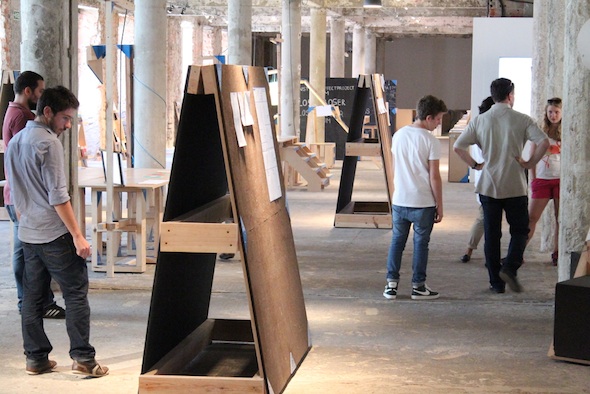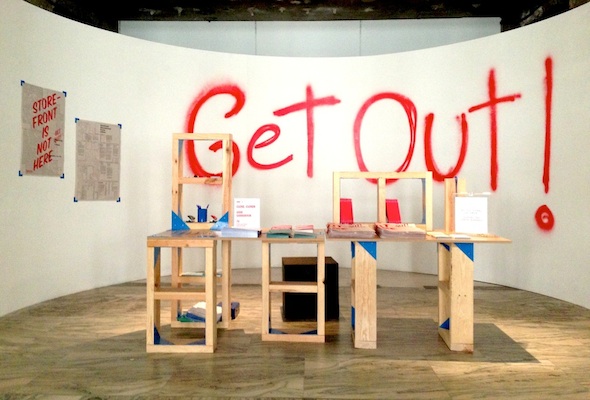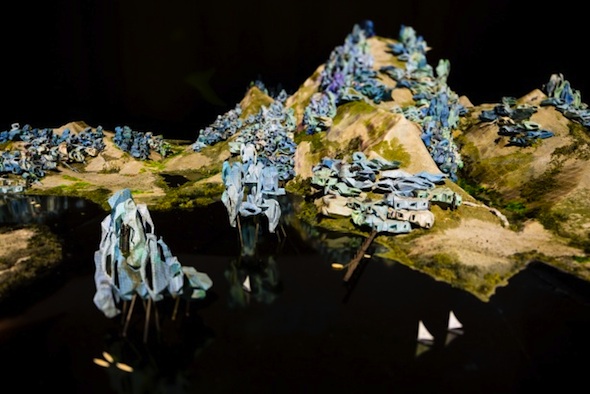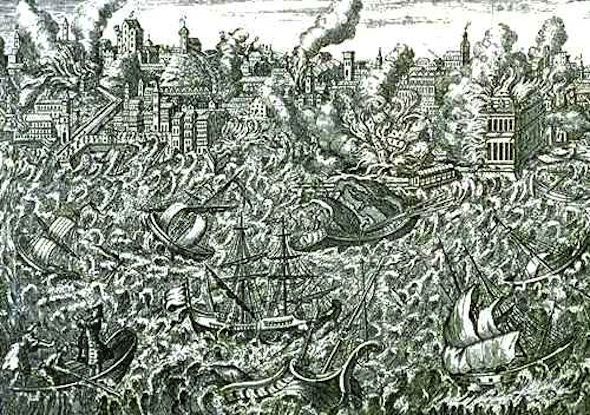Article by Marta Jecu in Lisbon; Thursday Oct. 31, 2013
This is part two of a two-part series. Parts 1 │ 2
 Interior Design by Strelka Institute; copyright Lisbon Architecture Triennale
Interior Design by Strelka Institute; copyright Lisbon Architecture Triennale
Detached from a literal understanding of architecture, the triennial Close, Closer slides between various framings of the “living experience”. These frames – a fiction of social forms of organization as retro-futuristic living nucleuses in the exhibition “Future Perfect”, the institution understood as a fluid and adaptable hub in “The Institute Effect” exhibition, and a re-enactment of past hypostases of Lisbon’s famous Marques de Pombal’s birth palace in “The Real and other Fictions” – are all set as an agenda to extract from architecture its agency. A set of talks, performances and events are meant to put these frameworks of “living” architecture into practice.
The triennial raises important questions: strolling around the exhibition halls the viewer is involuntarily led to think about the meaning of the ubiquitously pronounced ‘architectural practice’: what is its responsibility in its given context? How can architecture concretely react to a context that is by definition changing? How can a new thinking of architecture improve its social context and what are the limits of the discipline itself? In a triennial, what architecture “does” is highly dependent on the way it is exhibited but also on the flexibility of the context in relation to the ideas that it puts into circulation. And most of all, as Beatrice Galilee affirms, architecture should not be prescriptive.
The Crisis Buster grant seems a practical response to these questions. It is reminiscent of artists’ engagement actions since the avant-garde, when personal exhibition budgets were invested to improve the exhibition site itself, its immediate environment or working conditions. A modest amount was granted in Lisbon to ten projects that each propose some concrete solutions to fight scarce economic conditions like: saving small restaurants from closing down, offering food in poorly-developed neighbourhoods, making a local journal, organizing bricolage workshops, meeting networks, and platforms for goods recycling.
Alongside the Crisis Buster, the program also includes the “Debut Award”, the “Lifetime Achievement Award” (not disclosed yet), the “Architecture Student Award” and the “Associated Projects” Award.
Much like the triennial as a whole, these prizes manifest the attempt to tune the local scene to an international context, but nevertheless fail to address the immediate reality in Portugal and to address its real needs in a direct way. The “Debut award” for young architects is granted to a Chicago office: Bureau Spectacular/Jimenez Lai, while the university competition’s mentions are all granted to projects outside of Portugal.
 Interior Design by Storefront for Art and Architecture; copyright Lisbon Architecture Triennale
Interior Design by Storefront for Art and Architecture; copyright Lisbon Architecture Triennale
One of the three exhibitions, “The Institute Effect”, curated by Dani Admiss, is meant to explore the role of institutions in the art context today. The 12 institutions invited to participate are mostly dealing with art and architecture: among them The Strelka Institute (Moscow), The Institut fur Raumexerimente (Berlin), Salt Beyoglu (Istanbul) and the Urban Think Tank (Caracas). The empty hall in Lisbon’s Design Museum MUDE hosts rotating workshops consecutively from September to December 2013, while they leave their minimal traces in the overall design conceived by Fabrica, the design center of corporate giant Benetton. The institutions are supposed to present through workshops, lectures, and city wide interventions, finally culminating in actions such as cooking and eating a big paella in open air or urging the staff and visitors of the exhibition space to “Get out!” (the action of the New York Storefront for Art and Architecture). To what extent these actions are addressing the cultural requirements of the local art scene remains open. An already formulated set of exhibition design “solutions” and “performative approaches” applied on a local abstract “field” and in an empty exhibition hall seem to lack the realism necessary for exploring (and investing a budget into) what can be called spatial practice, with its concrete problems in Lisbon. These include the relation of contemporaneity with imminent problems of abandoned or ruined historic architecture and the reconsideration of a not-yet-explored architectural patrimony, among many other urgent issues.
“The Real and other Fictions” is another group show curated by the Portuguese architect Mariana Pestana, who was a guest in Carpe Diem Arte e Pesquisa, a project space located in the palace of Marques de Pombal (the architectural reformer who reconstructed Lisbon after the devastating earthquake of 1755). Here various past uses of the now semi-abandoned palace are restaged in interactive installations like a round table for making fanzines, an interactive sofa room that swallows the visitor, or a series of dinners where strangers can dine with an invited guest (paying for Portuguese standards the pricey fee of €35).
The most opaque of the three exhibitions, the group show “Future Perfect” (curated by Liam Young), is a set of retro-digital fictions, which sketches the future city as a collection of environments with uncertain identity. The title sounds bitingly ironic in the cultural context of today’s Portugal, with its devastating material constraints, that are nevertheless totally cropped out from the undetermined, a-social environment that the exhibition stages.
 The Schematics, Future Perfect’s movie miniature model cityscape; copyright Delfino Legnani
The Schematics, Future Perfect’s movie miniature model cityscape; copyright Delfino Legnani
The triennial’s over-designed, cryptic and text loaded website and visual interface by ZAK Group is jammed with equivocal statements: “Expect Everything and Nothing Else“ regarding the “Future Perfect” exhibition or “What else can architecture do?”, “When we dream”, “Less No”, “Places are for people and vice-versa”. Virtually, it brings us “Close, Closer” to a real space loaded with questions, but also with specific forces that require more structures of manifestation.
This is part two of a two-part series. Parts 1 │ 2
___________________________________________________________________________________
Additional Information
LISBON ARCHITECTURE TRIENNALE
“Close,Closer”: Lisbon Architecture Triennale
Sept. 12 – Dec. 15, 2013
___________________________________________________________________________________
Marta Jecu is presently a researcher at CICANT Institute in Lisbon, and has contributed to various magazines, including E-Flux, Kaleidoscope, Journal of Curatorial Studies, Idea Arta+ Societate, and various critical books, such as Visual Studies, Ed. Jim Elkins.
www.thinkaboutspace.net























